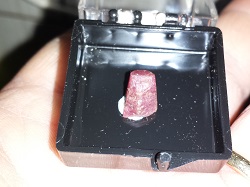A- |
B- |
C- |
D- |
E- |
F- |
G- |
H- |
I- |
J- |
K- |
L- |
M- |
N- |
O- |
P- |
Q- |
R- |
S- |
T- |
U- |
V- |
W- |
X- |
Y- |
Z |
RUBY:VARIETY OF: Corundum , Al2O3USES: Gemstone. BIRTHSTONE FOR: July COLOR: various shades of red. INDEX OF REFRACTION: 1.76 - 1.78 BIREFRINGENCE: 0.009 HARDNESS: 9 CLEAVAGE: none, although there is a rhombic parting CRYSTAL SYSTEM: trigonal PLEOCHROIC: strongly Ruby is the red variety of corundum, the second hardest natural mineral known to antiquity. The non-red variety of corundum is Sapphire. Sapphires are well known among the general public as being blue, but can be nearly any color. The red color in ruby is caused by trace amounts of the element chromium. The best shade of red for ruby is often given the name "pigeon blood red", but ruby can be any shade of red up to almost pink. Oriented rutile crystal inclusions cause a six-rayed-star light effect (called asterism) to form the popular Star Ruby. Rubies come from all over the world but good gemstones are found at Thailand, India, Madagascar, Zimbabwe, North Carolina in the U.S., Afghanistan, Pakistan, Sri Lanka, Kenya, Tanzania, Kampuchea, and perhaps most notably, Burma. Rubies have a famous place in science - the first lasers were made from artificial ruby crystals. They still are used for this purpose although other materials offer improved efficiency. Some ruby crystals show the fluorescence (actually very short term phosphorescence) that makes a laser possible. |

